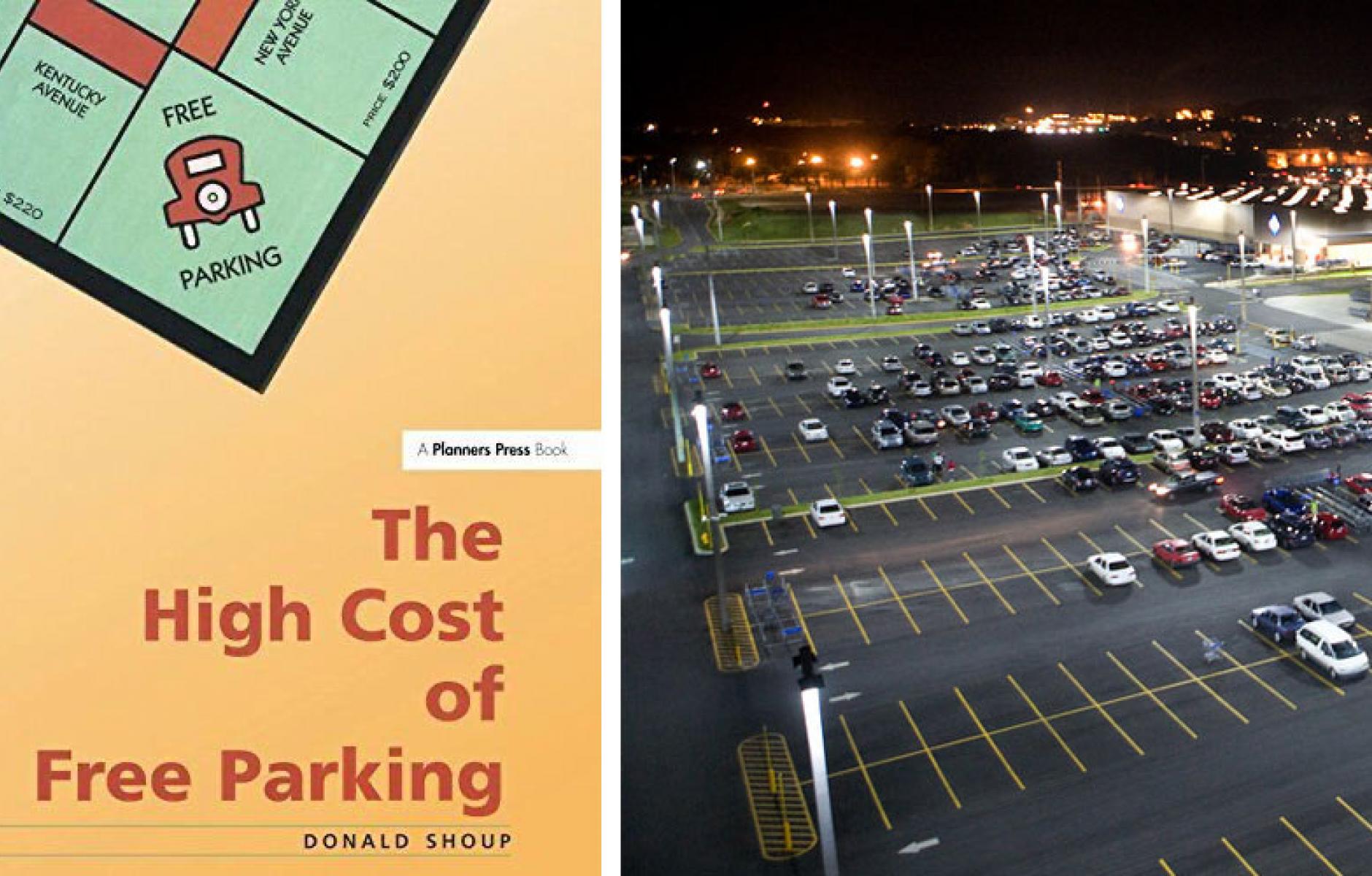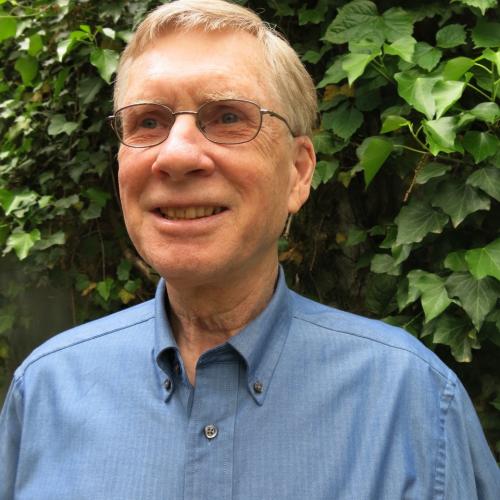
Pave paradise? No, ditch the parking lot
Editor's Note: A review of The High Cost of Free Parking was published in New Urban News in April, 2005, when the book was released. Subtitled “Planning expert Donald Shoup offers a novel solution to places damaged by too much parking,” the review by Philip Langdon captures why the book has been so influential. “His goal is the transform future debates about parking,” is an understatement—Robert Steuteville (founder of the late New Urban News and editor of Public Square).
For years, urbanists have tried a wide assortment of tactics to reduce the damage that parking inflicts on communities. Now comes UCLA urban planning professor Donald C. Shoup with a radical, yet carefully argued prescription: Governments should stop requiring off-street parking. In The High Cost of Free Parking, Shoup systematically attacks ingrained ideas that have prevented urbanists from asking the most basic question of all: Why should governments require parking other than on the streets?
“Few people now recognize parking requirements as a disaster because the costs are hidden and the harm is diffused,” Shoup says in the 734-page, $59.95 hardcover from APA Planners Press. He contends that “parking requirements cause great harm: they subsidize cars, distort transportation choices, warp urban form, increase housing costs, burden low-income households, debase urban design, damage the economy, and degrade the environment.” His verdict: “Off-street parking requirements have all the hallmarks of a great planning disaster.”
A Yale-trained economist and former director of the Institute of Transportation Studies at UCLA, Shoup says the longstanding municipal practice of assigning parking requirements is nonsense. “Urban planners set minimum parking requirements for every land use, but the requirements often seem pulled out of thin air or based on studies that are poorly conceived,” he says. “In turn, these faulty standards and policies are perpetuated as they are copied from one city to the next.” The planning profession, in its eagerness to be comprehensive, has identified more than 600 different uses, each with its own parking requirement. “A gas station must provide 1.5 parking spaces per fuel nozzle, and a mausoleum must provide parking spaces per maximum number of interments in a one-hour period. Why?” he asks. “Nobody knows.”
Shoup has written a biting volume that presents detailed examples and exhibits high ambition. His goal is to transform future debates about parking and save cities and towns from what he sees as misguided attempts to make parking “free” and plentiful. After they have considered the evidence, Shoup says, “I believe planners will eventually admit that off-street parking requirements are a well-intentioned folly similar to lead therapy — a poison prescribed as a cure.”
In assailing the parking-requirement enterprise, Shoup argues:
- “Off-street parking requirements encourage everyone to drive wherever they go because they know they can usually park free when they get there.” Those who don’t drive nonetheless subsidize the parkers, through higher prices that are charged to everyone for goods and services.
- “Parking requirements create especially severe problems in older commercial areas,” where it is often impossible to erect new buildings at traditional densities while satisfying municipal parking ratios. Shoup says such requirements “have hindered the rebuilding of Los Angeles’s older retail corridors that were destroyed in the 1992 riots.”
- “Off-street parking requirements especially harm low-income and renter families because they own fewer cars but still pay for parking indirectly.” Nonprofit developers in San Francisco have estimated that parking requirements add 20 percent to the cost of each affordable housing unit and reduce the number of units that can be built on a site. “We’re forcing people to build parking that people cannot afford,” observes Amit Ghosh, the city’s chief of comprehensive planning. A study in Oakland, California, found that requiring one parking space per dwelling “increased housing costs by 18 percent and reduced density by 30 percent.”
- “Past some critical point, more parking spaces harm rather than help” the central business district. They reduce compactness and proximity — chief advantages of an urban location.
- “Popular historic styles like courtyard housing cannot be replicated with today’s parking requirements.”
New urbanists, also
New urbanists need to pay close attention to parking, Shoup says. He notes that the SmartCode produced by Duany Plater-Zyberk & Company and intended to facilitate urban development nonetheless includes parking requirements, such as three spaces per 1,000 square feet of retail in a city center. “Even at the fountainhead of new urbanist thinking, parking requirements dictate density, and cars rule the city,” Shoup asserts.
Much of the solution to the parking morass lies in letting the market decide how much parking is provided, and where, Shoup suggests. Presumably the result will be fewer parking lots, a higher density of development, and a shift toward mass transit, bicycling, walking, and other forms of movement. The money saved can be put to other uses. He notes, “In 2002, the total subsidy for off-street parking was somewhere between $127 billion and $374 billion a year. If we also count the subsidy for free and underpriced curb parking, the total subsidy for parking would be far higher.”
“Reducing or removing off-street parking requirements … can increase the supply and reduce the price of all housing, without any subsidy,” Shoup contends. “Many brownfield sites that are now difficult to redevelop may suddenly find economic uses if cities remove off-street parking requirements.”
If less off-street parking were supplied, wouldn’t motorists tend to park on the streets, especially where spaces are free? Yes, Shoup acknowledges. So he suggests changing municipal policies on curb parking, too. “I recommend charging for curb parking (which does not necessarily require conventional parking meters, of course) whenever there would be a shortage of curb spaces in the absence of charging,” Shoup told New Urban News. If parking is not in short supply when it’s free, there is no reason to charge for it, according to Shoup. “I recommend the classic Goldilocks method of setting the prices for curb parking: the price is too high if too many spaces are vacant, and the price is too low if no spaces are vacant. When about 15 percent of the spaces are vacant, the price is just right.”
Charging market-rate prices for on-street parking would bring in revenue from parkers and, in his view, it would discourage unnecessary automobile use. He notes that free or low rates at meters encourage motorists to cruise the streets, generating congestion and pollution while looking for spaces that are cheaper than those in parking garages. Cities could review their parking rates and adjust them to the demand. In entertainment and shopping districts that stay busy until late in the evening, meters might charge $2 an hour during the day, $3 in the evening, and become free after 2 a.m.
One way to make the shift from free on-street parking palatable would be to establish “parking benefit districts.” These are organizations, possibly at the neighborhood level, that would decide the rates for curb parking in their area and receive at least part of the revenue. They could spend the money on public benefits for the neighborhood, Shoup says.




